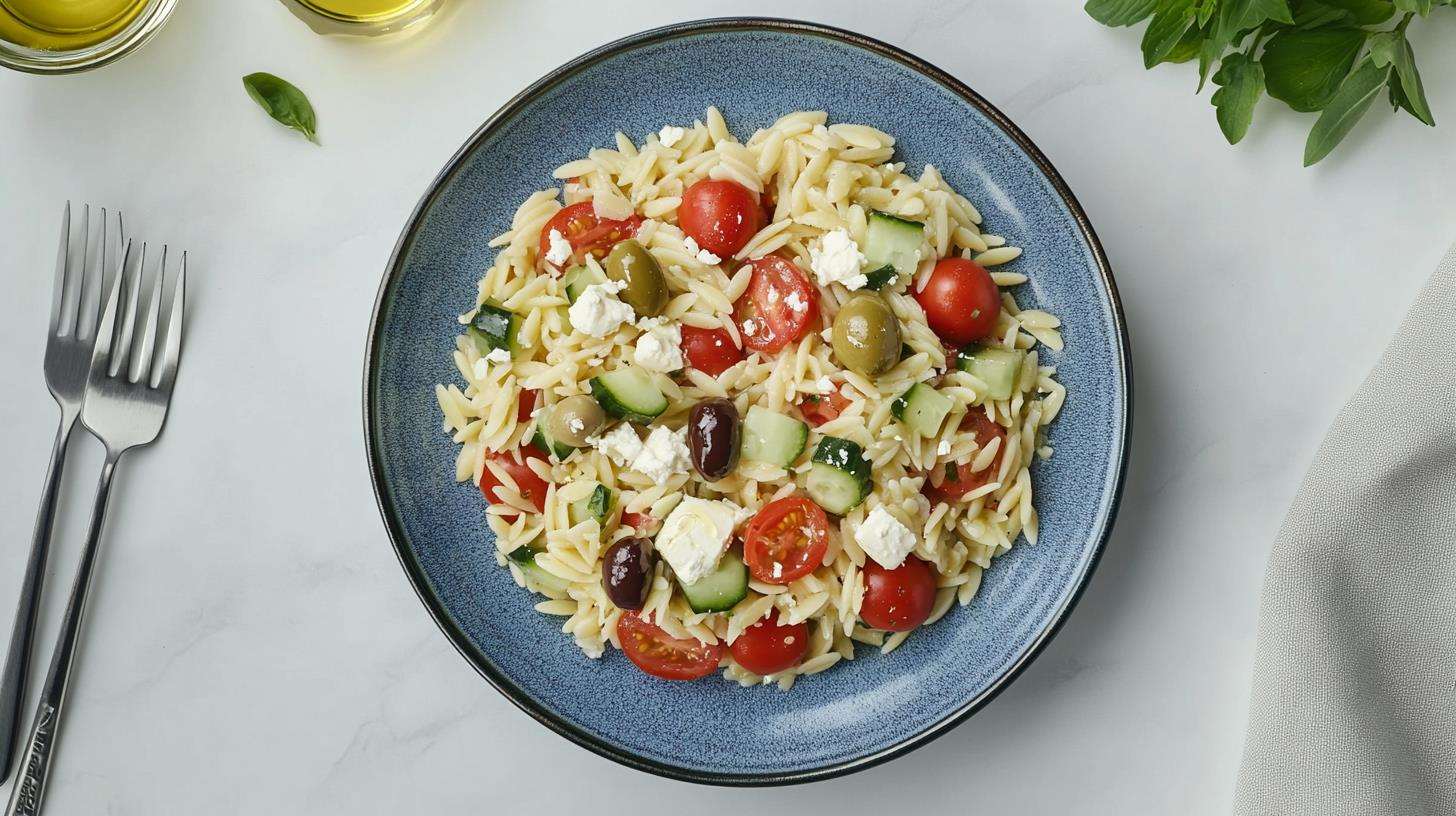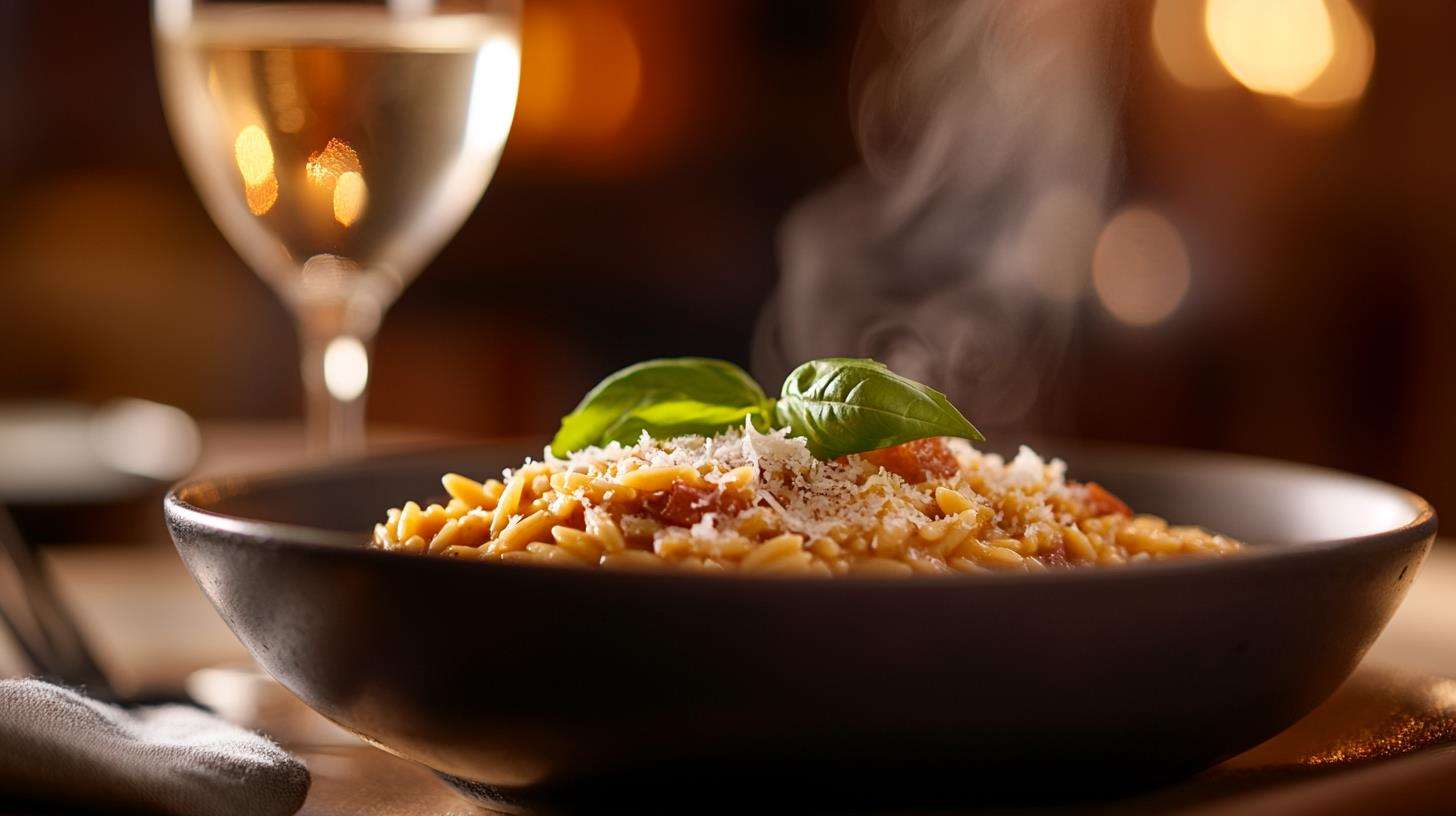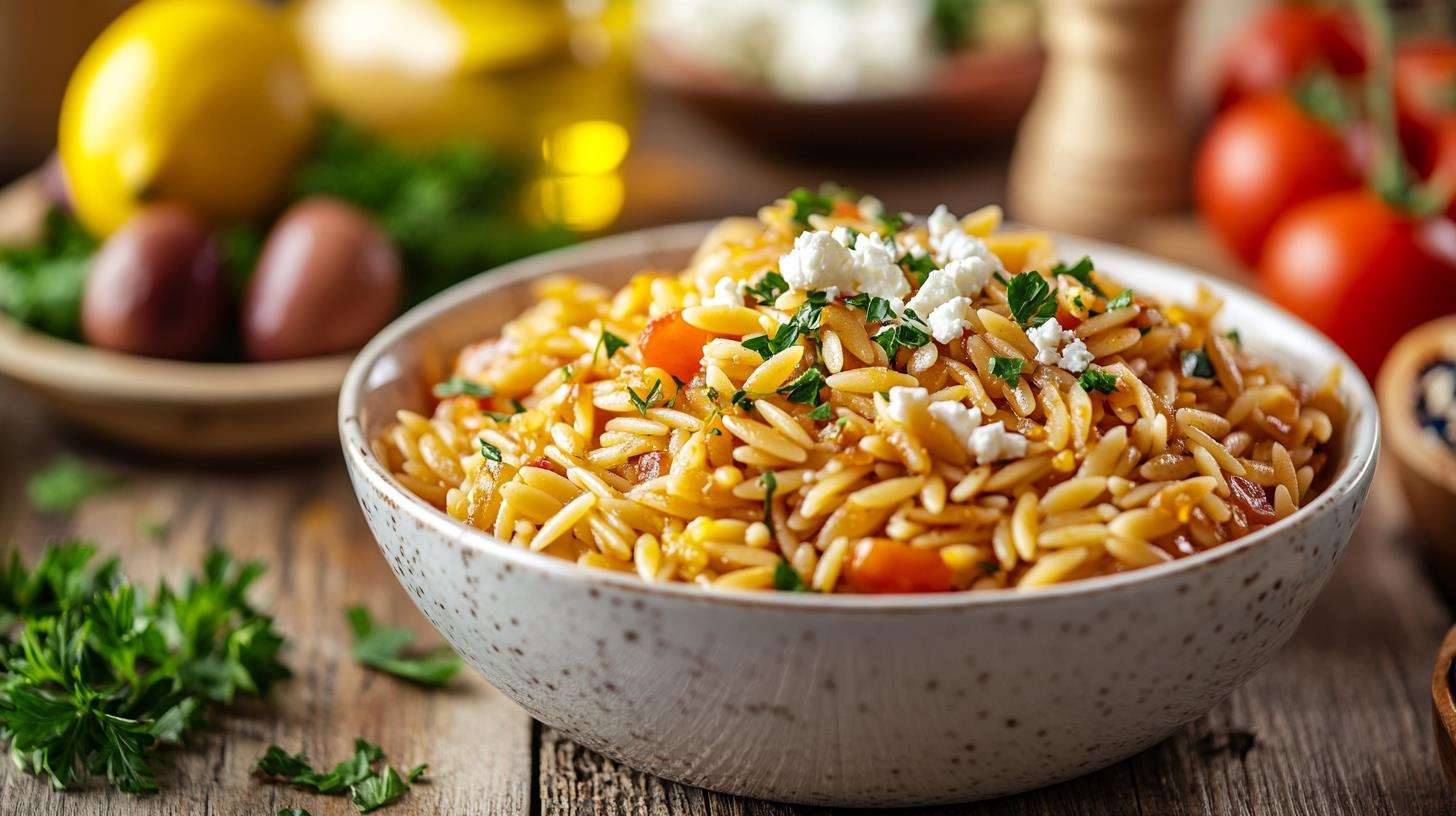Why is orzo different from pasta? This question often comes up when exploring orzo’s unique role in the culinary world. While orzo is technically a type of pasta, its small, rice-like shape and versatile applications set it apart from traditional pasta varieties. From soups and salads to creamy risottos, orzo is a kitchen staple with a personality all its own. This article delves into the differences, uses, and cooking tips for orzo, helping you understand why it stands out.
Understanding Orzo and Pasta
What Is Orzo?
Why is orzo different from pasta? The answer begins with its unique identity. Orzo, derived from the Italian word for barley, orzo, is a small, rice-shaped pasta made from semolina flour, just like traditional pasta. Despite its grain-like appearance, orzo is firmly categorized as pasta due to its composition and preparation methods.
What truly sets orzo apart is its versatility. Unlike traditional pasta shapes, which are often the star of saucy main courses, orzo excels as a complementary ingredient. It seamlessly blends into soups, salads, and casseroles, creating a balanced dish without overwhelming other ingredients. This versatility is a key reason why orzo is different from pasta.
What Defines Pasta?
To understand why is orzo different from pasta, we first need to define pasta itself. Traditional pasta is crafted from wheat flour (often semolina) and water, creating a dough that is shaped, boiled, and served in a variety of styles. From long strands like spaghetti to intricate shapes like farfalle, pasta comes in countless forms designed to hold sauces or enhance specific dishes.
Orzo, while part of the pasta family, breaks the mold by mimicking grains. This small, rice-like shape allows orzo to function more like couscous or rice in recipes. As a result, it can be used in dishes where larger pasta shapes might feel out of place.
Orzo’s Role Within Pasta
Another key aspect of why orzo is different from pasta lies in its role within the culinary world. While spaghetti and penne often serve as the foundation of a meal, orzo is a flexible addition that adapts to various cuisines. Its small size and neutral flavor make it perfect for absorbing the flavors of broths, dressings, and seasonings.
By exploring orzo’s characteristics, it becomes clear that why is orzo different from pasta isn’t just a question of shape but of application. Orzo’s versatility, ease of preparation, and ability to mimic grains make it a standout ingredient that bridges the gap between pasta and other staples like rice.
Key Differences Between Orzo and Pasta
Shape and Size Differences
Why is orzo different from pasta? The first and most obvious difference lies in its shape and size. Orzo resembles rice rather than the long strands or hollow tubes typical of traditional pasta like spaghetti or penne. This rice-like appearance makes orzo a unique ingredient, ideal for dishes that require a smaller, subtler texture.
Traditional pasta often relies on its distinct shapes—such as spirals, ribbons, or shells—to complement sauces and add variety to meals. However, orzo’s compact size allows it to blend seamlessly into soups, salads, and casseroles without overwhelming other ingredients. This versatility is one of the key reasons why orzo is different from pasta.
Culinary Applications
When answering why is orzo different from pasta, its uses in recipes provide a clear explanation. Orzo often takes on the role of a grain substitute, standing in for rice or couscous in dishes like pilafs and grain salads. It absorbs flavors beautifully, whether simmered in broth or dressed in vinaigrettes.
In contrast, traditional pasta is more likely to be the star of the dish, often paired with rich sauces like marinara or Alfredo. Orzo, on the other hand, excels as a supporting ingredient, adding texture and balance to soups, side dishes, and baked recipes. This ability to adapt and enhance various dishes highlights why orzo is different from pasta.
Orzo can also replace rice in creamy dishes, such as risottos, where its small size helps it absorb liquids more quickly than traditional pasta shapes. This dual role as a pasta and a grain substitute makes orzo incredibly versatile in the kitchen.
Nutritional Comparison
Exploring why is orzo different from pasta also involves looking at their nutritional profiles. Both orzo and pasta are made from semolina flour, but orzo typically contains slightly fewer calories per serving. For instance, 1 cup of cooked orzo has about 200 calories, compared to traditional pasta, which can have slightly more.
However, traditional pasta often provides more protein and fiber, making it a better option for those focused on these nutrients. Despite this, orzo’s adaptability allows it to be paired with fiber-rich vegetables and protein-packed ingredients, balancing its nutritional profile.
When considering why is orzo different from pasta, it’s clear that orzo’s smaller size, versatility in recipes, and unique uses make it a standout ingredient. Whether you’re adding it to a hearty soup or swapping it for rice in a salad, orzo offers a distinctive twist on the pasta experience.
Cooking and Preparing Orzo
Secrets to Cooking Orzo Perfectly
Why is orzo different from pasta when it comes to cooking? The answer lies in its size and texture. Orzo, with its rice-like shape, requires a slightly different approach to achieve the perfect bite. Start by bringing a large pot of salted water to a boil. Use a ratio of 3 cups of water for every cup of orzo to prevent it from clumping together. Cook the orzo for about 8–10 minutes, stirring occasionally, until it reaches an al dente texture—tender but still firm to the bite.
For cold salads, rinsing orzo under cold water after draining is essential to stop the cooking process. This step is another example of why orzo is different from pasta, as most traditional pasta dishes benefit from retaining their surface starch for sauce adhesion.
Flavor Enhancements
Another reason why is orzo different from pasta lies in its ability to absorb flavors effortlessly. Instead of boiling it in plain water, consider cooking orzo in chicken, vegetable, or beef broth. This technique infuses the orzo with depth, transforming it into a flavorful base for salads, soups, or side dishes.
Adding olive oil, butter, or herbs like basil and thyme immediately after draining further enhances the flavor while preventing sticking. Orzo’s ability to absorb seasonings showcases why orzo is different from pasta in its culinary adaptability.
Storage and Reheating Tips
Cooked orzo stores well, making it perfect for meal prep. Place it in an airtight container and refrigerate for up to five days. When reheating, add a splash of water or broth to restore moisture and prevent clumping. This step underscores why orzo is different from pasta, as its smaller size makes it more prone to drying out during storage.
By understanding these cooking and storage tips, you’ll see why is orzo different from pasta in both preparation and versatility. Whether used as a base for salads or a creamy main dish, orzo continues to stand out as a unique and adaptable ingredient.
Creative Recipes Featuring Orzo
Orzo Salad Variations
When asking why is orzo different from pasta, its adaptability in recipes like salads often comes to mind. Orzo’s small, rice-like shape absorbs dressings and flavors beautifully, making it perfect for light and refreshing dishes. A Mediterranean Orzo Salad is a crowd favorite, combining cooked orzo, juicy cherry tomatoes, diced cucumbers, sliced olives, and crumbled feta cheese. Drizzle with olive oil, fresh lemon juice, and oregano for a delightful flavor burst.

For something more unique, try a Spinach and Parmesan Orzo Salad. This dish showcases why is orzo different from pasta by blending sautéed spinach, grated Parmesan, and a touch of garlic with the tender orzo. It’s ideal as a side dish or a satisfying lunch.
Explore more ways to incorporate orzo into salads with Parmesan Spinach Orzo, a versatile recipe full of flavor.
Soups and Stews
Why is orzo different from pasta? One reason is its ability to complement hearty soups and stews. Orzo’s small size allows it to blend seamlessly into broths without overwhelming the dish. A classic Chicken and Spinach Orzo Soup pairs shredded chicken, fresh spinach, and orzo in a savory broth for a comforting meal.
For a vegetarian twist, a Lemon Orzo Soup combines orzo with chickpeas, fresh dill, and a tangy lemon broth. The way orzo absorbs these bold flavors highlights yet another reason why is orzo different from pasta.
More Relevant Soup Recipes
Main Dish Ideas
Orzo shines as the star of main dishes, providing a creamy base for endless possibilities. A Baked Orzo with Vegetables dish layers roasted zucchini, bell peppers, and eggplant with cooked orzo, topped with mozzarella before baking to golden perfection.
Want something indulgent? Creamy Orzo Risotto is a fantastic example of why is orzo different from pasta. By cooking orzo risotto-style, it absorbs broth gradually and achieves a velvety texture without the fuss of traditional risotto.
FAQs About Orzo and Pasta
What Is Orzo, and How Is It Related to Pasta?
Orzo is a type of small pasta that resembles rice. It’s made from semolina flour, which is also used for traditional pasta. What makes orzo stand out is its shape and versatility—it works as a grain substitute in pilafs, risottos, and soups, yet it’s still technically a pasta. This distinction is a big reason people ask, why is orzo different from pasta?
Is Orzo Gluten-Free?
No, traditional orzo is not gluten-free, as it’s made from durum wheat. However, for those with gluten sensitivities, gluten-free orzo made from rice or other grains is readily available. These options retain a similar texture and flavor, making them perfect substitutes.
Can Orzo Be Substituted for Other Pasta Types?
Absolutely! Orzo’s versatility makes it an excellent substitute for other small pasta like ditalini or even grains like rice and couscous. Keep in mind that orzo cooks quickly, so you may need to adjust cooking times if swapping it into recipes designed for larger pasta shapes.
How Should Orzo Be Cooked?
Cooking orzo is simple: use a 3:1 water-to-orzo ratio, boil for 8–10 minutes, and drain. If using it in a cold salad, rinse it under cold water to stop the cooking process. For hot dishes, toss cooked orzo with butter or olive oil to prevent sticking.
For more meal ideas and recipes, consider exploring Parmesan Spinach Orzo or check out other featured recipes on the site. Stay tuned for the conclusion to summarize why orzo deserves a spot in your pantry!
Conclusion: Is Orzo Really Pasta?
Orzo’s identity as pasta may seem straightforward at first glance, but its versatility and distinct characteristics often blur the lines. Technically, orzo is pasta, crafted from the same semolina flour as spaghetti or penne. However, its small, rice-like shape and ability to mimic grains make it a unique addition to the culinary world.
So, why is orzo different from pasta? Its size, texture, and culinary applications set it apart. Orzo blends effortlessly into soups, salads, and casseroles, absorbing flavors without dominating the dish. It also opens doors for creative substitutions, standing in for rice or couscous in recipes.
Orzo’s ability to be served hot or cold, as a side or a main dish, cements its place as a versatile kitchen staple. Whether you’re crafting a creamy risotto, a hearty soup, or a refreshing salad, orzo offers endless possibilities. While it shares pasta’s core ingredients and preparation, it truly shines in dishes where traditional pasta shapes might feel out of place.
Adding orzo to your pantry allows for innovative meals that balance texture, flavor, and ease. Embrace its uniqueness and enjoy experimenting with this standout ingredient!
The Nutritional Perspective on Orzo
How Does Orzo Compare Nutritionally to Traditional Pasta?
When exploring why is orzo different from pasta, understanding its nutritional makeup is essential. Both orzo and traditional pasta are made from semolina flour, offering similar calorie and carbohydrate counts. However, orzo tends to have a slightly lower protein and fiber content compared to larger pasta varieties like penne or spaghetti.
A standard serving of cooked orzo (1 cup) contains about 200 calories, 4 grams of protein, and 1 gram of fiber. Traditional pasta, on the other hand, might provide up to 8 grams of protein and 2 grams of fiber for the same serving size. This makes traditional pasta a better option for individuals seeking higher protein and fiber intake.
Orzo’s Role in a Balanced Diet
Despite its modest nutritional profile, orzo fits well into a balanced diet, especially when paired with nutrient-dense ingredients. Tossing orzo with vegetables, lean proteins, and healthy fats can create a well-rounded meal that’s both satisfying and flavorful.
If you’re mindful of gluten, note that orzo isn’t gluten-free. However, gluten-free options made from rice or quinoa provide an excellent alternative, offering a similar texture without sacrificing dietary preferences or needs.

Cooking Tips and Tricks for Perfect Orzo
Secrets to Cooking Orzo Like a Pro
To achieve perfectly cooked orzo, start with a generous pot of salted boiling water. Use a water-to-orzo ratio of at least 3:1 to prevent clumping. Cook for 8–10 minutes, stirring occasionally, until the orzo reaches an al dente texture. If you’re using orzo in a cold dish, rinsing it under cold water after draining helps stop the cooking process and prevents sticking.
For richer flavors, try cooking orzo in broth instead of water. This simple switch enhances the taste and eliminates the need for excessive seasoning later. Adding a splash of olive oil or butter immediately after draining helps keep orzo from clumping, especially if it’s waiting to be mixed with other ingredients.
Enhancing Orzo with Simple Additions
Orzo’s mild flavor makes it a perfect canvas for bold ingredients. Toss cooked orzo with garlic, lemon zest, or fresh herbs like basil or parsley for a quick side dish. You can even mix it into casseroles, stir-fries, or creamy sauces for an elevated meal.
By understanding these cooking tips, you’ll always achieve flavorful and perfectly textured orzo. And next time you’re in the kitchen, you’ll know why is orzo different from pasta—it’s pasta with a twist!

